PDF version [PDF: 244KB]
Introduction: Phases of the Postwar Japanese Economy
More than 70 years have passed since the end of World War II. In this period, the Japanese government, more specifically the Ministry of Commerce and Industry (1945-1949), the Ministry of International Trade and Industry (MITI, 1949-2001) and the Ministry of Economy, Trade and Industry (METI, 2001-present) designed and implemented a number of industrial policies, i.e. micro-level policy interventions to firms, industries and markets. In this article, after dividing the postwar history of the Japanese economy into three phases, I briefly describe the industrial policies implemented in each of these phases.
Chart 1 shows the growth path of per capita GDP in Japan, measured by international Geary-Khamis dollars at 1990 prices, compared with that of the United States. We can clearly identify three phases in the postwar growth path of the Japanese economy. First, in the period of economic recovery and high growth (1945-1973), the average annual growth rate was 7.6%. It is notable that, during the recovery process, the growth rate was almost as high as that in the so-called "high-growth period" after 1955. This first phase can be divided into two sub-phases, the first when the Japanese economy was under the control of the government (1946-1949), and the second after the transition to a market economy (1949-1973). Second, in the period of stable growth (1974-1990), the average growth rate substantially declined, but it was still higher than that of the US, and Japan almost achieved its goal of catching up with the advanced Western countries, which it had long been aiming for since the Meiji Restoration in 1868. Finally, in the period of long stagnation after 1991, the average growth rate declined to less than 1%. In these macroeconomic environments, the government attempted to address various economic issues using industrial policies.
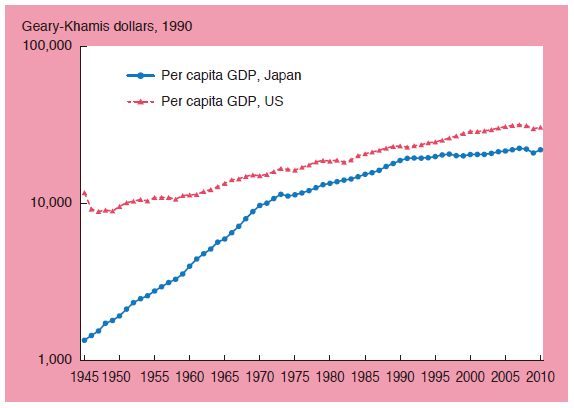
Economic Recovery under Planning & Control
In 1945, when World War II ended, per capita GDP in Japan declined sharply, falling as low as 50.6% of that in 1944. Furthermore, the decline in industrial production was still more serious. As shown in Chart 2, the production index of the mining and manufacturing industries was around 20-30% of the prewar level. Meanwhile, inflation was galloping. In this critical situation, reconstruction of the economy was an urgent issue for the government. As the scarcest materials were coal and steel, a policy to promote the production of these two materials, the "priority production policy", was implemented in 1947 and 1948.
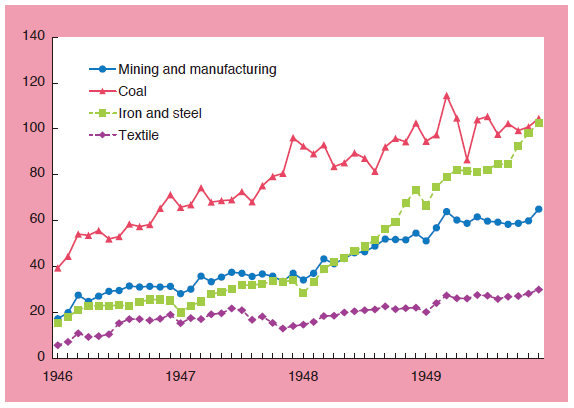
This policy had a special feature, reflecting the characteristics of the regime under which the Japanese economy operated in this period. Since the late 1930s, when the Sino-Japanese War broke out, a large part of the Japanese economy had been under the planning and control of the government. Prices were controlled and, accordingly, commodities were rationed, based on the plan decided by the government. The priority production policy was implemented based on this system.
In order to increase the production of coal and steel, materials were concentrated into those two industries by distribution control. Further, the government established a special public financial institution, the Reconversion Finance Bank (RFB). According to the fund allocation plan by the government, the RFB selectively loaned money to the firms that were supposed to be essential to recovering production of the strategic industries, including coal and steel. To perform this function, the RFB raised funds by selling its bonds directly to the Bank of Japan (BOJ). The impact of this policy on industrial production is shown in Chart 2. After the policy commenced in January 1947, coal production increased, but it is not clear whether it was because of the policy, as it also increased prior to the policy's introduction. It is noteworthy that steel production started to increase from early 1947. We can say that the direct impact of the priority production policy was on the recovery of steel production, which arguably contributed to making an increase in coal production sustainable.
On the other hand, it is also notable that textile production declined in 1947. As resources were concentrated in the coal and steel industries, the allocation of resources to other industries was reduced by the policy. In this sense, the decline in textile production was a negative side effect of the priority production policy. This policy had other negative side effects as well. The policy, in giving priority to production increases, reduced the incentive of private firms to enhance efficiency, and the monetization of the RFB bonds by the BOJ accelerated inflation.
Transition to Market Economy & Promotion of Industries
The Japanese economy transited from a regime of planning and control to a market economy in 1949, when the US minister Joseph Dodge came to Japan to give advice on economic policy to the occupation authorities (GHQ) and the Japanese government. With respect to macroeconomic policy, Dodge instructed the Japanese government to balance its budget, stop new loans from the RFB, and set a fixed exchange rate of 360 yen per US dollar. With this set of three policies, Dodge intended to stop high inflation and stabilize the macroeconomy. Meanwhile, with respect to microeconomic policy, he instructed the government to abolish controls on prices and distribution. Backed by the powers of the occupation authorities, these policies were implemented swiftly, making the Japanese economy successfully transit to a market economy.
Abolition of government controls and the fixed exchange rate implied that Japanese industries and firms had to compete with each other and with foreign industries and firms. The government considered that it was necessary to promote new industries because some of the existing industries would lose competitiveness compared with the industries in developing countries, which would endeavor to promote industries based on low wages. However, direct controls, which had been employed for industrial policy, were outdated. In this circumstance, the government devised a set of new tools for industrial policy.
First, two new public financial institutions, the Export Bank of Japan (EBJ) and the Japan Development Bank (JDB), were established in 1950 and 1951, respectively. The EBJ was renamed the Export-Import Bank of Japan (EIBJ) in 1952. The funds for these financial institutions were mainly from the Fiscal Investment and Loan Program (FILIP), which started in 1948. FILIP is a program that invests and loans government funds to the private sector. The largest portion of its funds came from postal savings. The EIBJ and JDP were two of the major channels through which FILIP funds were loaned to the private sector, with low-interest rates.
Second, a program of special administrative tax relief was introduced by the Enterprise Rationalization Promotion Law in 1952. The government reduced corporate tax in cases where a firm installed certain sorts of equipment that were effective in promoting rationalization, according to the law, and thereby promoted investment in new equipment. Third, the Enterprise Rationalization Promotion Law also prescribed subsidies for R&D. Policy-based finance, tax relief and subsidies for R&D have been employed as the major industrial policy tools up to the present.
Besides these tools, there was another powerful policy tool utilized in the 1950s, the foreign exchange allocation system. In the 1950s, all foreign exchange was concentrated with the government, which then allocated foreign exchange based on the "foreign exchange budget." The part of the budget for commodity imports was drawn up by MITI. The foreign exchange budget was classified into two categories, the budget for foreign exchange allocation goods (FA goods) and that for automatic approval goods (AA goods). As shown in Chart 3, the FA budget accounted for 70-80% of the total foreign exchange budget.
The distinction between the FA and AA budgets was essential because, with respect to the FA goods, the budget was allocated to individual commodities. This implied that MITI could impose de facto import quotas on FA commodities, using the foreign exchange allocation budget, given their prices. MITI used this system to protect domestic industries. Meanwhile, in relation to industries that heavily depended upon imported raw materials, by controlling foreign exchange allocations to the raw materials, MITI could indirectly control production in those industries. Furthermore, it is notable that MITI allocated the foreign exchange budget for each FA good to individual firms. This implies that MITI allocated rent to individual firms because the import of FA goods was more or less restricted. Thus, MITI promoted exports and investment of individual firms by linking the foreign exchange allocation to exports and equipment, respectively. The foreign exchange allocation system continued until the early 1960s, when Japan implemented the "trade liberalization" recommended by the IMF, GATT, and the US government.
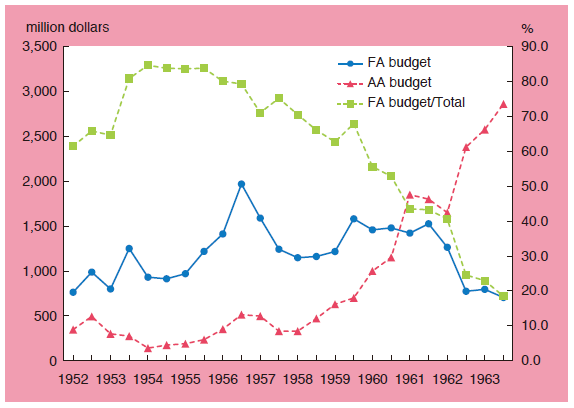
In the high growth period, combining those tools, the government implemented various industrial policies. They included the policy for updating the equipment of basic industries (power generation, iron and steel, etc.), and promotion of new industries (synthetic fibers, automobile, petrochemical, computers, etc.). They were typical "targeting" policies, which aimed at promoting the industries that were regarded as strategic by the government.
The "industrial rationalization" policy in the 1950s was a case of a targeting policy. When the Japanese economy transited to a market economy in 1949, the iron and steel industry had a problem in that its production equipment was out of date. Chart 4 indicates the distribution of the vintage of rolling mills in Japan. More than half of the rolling mills in terms of capacity were installed before the Sino—Japanese War. In particular, concerning the mills for sheet steel, the Japanese iron and steel industry was far behind in introducing strip mills. Hence, MITI supported iron and steel firms to invest in strip mills through loans from the JDB and the allocation of foreign exchange to import strip mills. An increase in investment in new rolling mills is reflected in the shift of the vintage distribution from 1949 to 1955 and 1960. In the 1950s, iron and steel equipment in Japan grew younger, which in turn contributed to the international competitiveness of the Japanese iron and steel industry. Indeed, steel became one of the major export commodities from Japan, which caused trade frictions with the US in the 1960s.
Meanwhile, in the high growth period, some industries, such as the coal and natural fiber industries, lost a comparative advantage. For these declining industries, the government implemented the industrial adjustment policy to facilitate capacity reduction. The adjustment policy for the coal industry started in 1955 when the Coal Industry Rationalization Law was legislated. Under this law, the Coal Industry Improvement Public Corporation was established to buy inefficient mines from private mining firms to scrap.
Shift of Growth Path & Industrial Adjustment
The First Oil Crisis in 1973 was not only a turning point in the growth of the macroeconomy, but it also had impacts on individual industries. In particular, the sharp rise in the oil price damaged the basic material industries, which were energy intensive, and many of them subsequently faced a structural depression. Chart 5 shows the return on assets (ROA) and the operation of equipment of the manufacturing industries. The ROA substantially declined after the oil crisis, and it is clearly correlated with the decline in the operation rate of equipment. As suggested in this chart, manufacturing industries, particularly the basic material industries, faced a problem of excess capacity. In these circumstances, MITI extensively implemented the industrial adjustment policy from the late 1970s to the 1980s. The legal framework was provided by the Law on Temporary Measures for Stabilization of Specified Depressed Industries (1978) and the Designated Industries Structural Revision Extraordinary Measures Law (1983).
Under these laws, MITI designated depressed industries facing structural problems. Each designated industry drew up a plan for equipment disposal to be approved by MITI, which supported the implementation of the plan with policy-based finance, tax relief and exemptions from the Antitrust Law. Fourteen and 26 industries were designated by the Law on Temporary Measures for Stabilization of Specified Depressed Industries and the Designated Industries Structural Revision Extraordinary Measures Law, respectively.
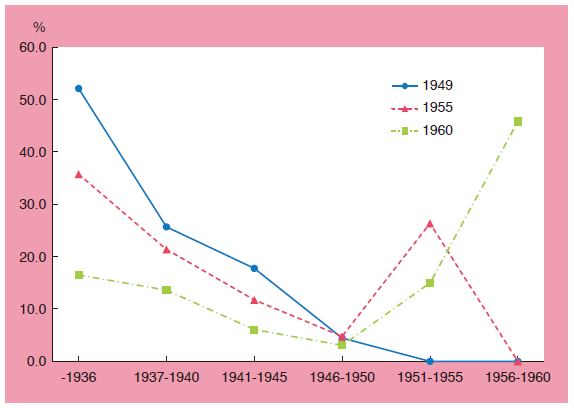
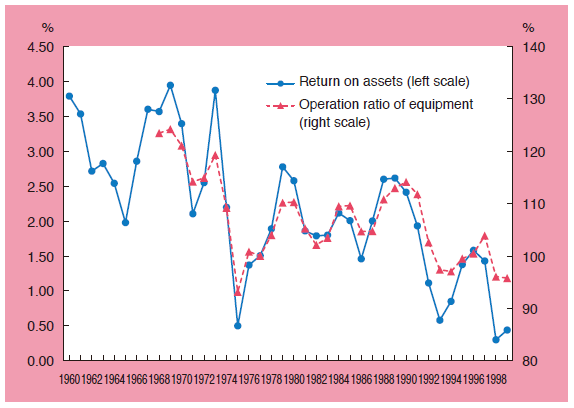
Table 1 reports the results of regression analyses on the effects of the Designated Industries Structural Revision Extraordinary Measures Law. The observations are for 120 manufacturing industries, of which 26 were designated by the law, and they cover seven years (1980-1986), which include the period before and after the enactment of the law. The variable "Law" is a dummy variable, which equals one if an industry was designated by the law in a year. Hence, the coefficient of "Law" captures the impact of the law in the sense of difference in differences. The coefficients of "Law" are positive and statistically significant in all cases where we use ROA, TFP growth and labor productivity growth as the dependent variables. It is suggested that the Designated Industries Structural Revision Extraordinary Measures Law was effective in improving profitability and productivity of the designated industries.
On the other hand, the industrial adjustment policy by MITI was criticized by the US in the context of bilateral economic friction in the 1980s. From 1983 to 1984, the Industrial Policy Dialogue was held between Japan and the US, during which the US argued that the competitiveness of Japanese firms was nurtured by promotional policies targeting strategic industries and, hence, that it was unfair. In addition, the US criticized the Designated Industries Structural Revision Extraordinary Measures Law, arguing that it aimed at preserving declining industries and was a barrier to imports. Facing these criticisms, along with the criticism of an expanding surplus on the current account balance, the Japanese government made efforts to compromise with the US government, which was reflected in the Maekawa Report in 1986.
This circumstance brought about a substantial change in industrial policy, especially the industrial adjustment policy. Because of the sharp appreciation of the yen after the Plaza Agreement in 1985, industrial adjustment was still an important issue for industrial policy in the late 1980s. However, the approach and tools for industrial adjustment became substantially different from those utilized in the early 1980s. In 1987, the Law for Facilitating Transformation of Industrial Structure was legislated, succeeding the Designated Industries Structural Revision Extraordinary Measures Law. This law differed from the 1983 law in that its objects were individual firms and areas, not industries, and that it did not include exemptions from the Antitrust Law. These characteristics distinguish the policies after the late 1980s from the traditional industrial policies prior to that time. Shinji Fukukawa, who was administrative vice-minister of MITI from 1986 to 1988, states that, in retrospect, "We decided not to renew the Designated Industries Structural Revision Extraordinary Measures Law, and to take a measure to depressed areas" and "the Designated Industries Structural Revision Extraordinary Measures Law was the last policy targeting individual industries." He evaluated this change as indicating the transition of industrial policy from an industry-oriented policy to a market-oriented one.
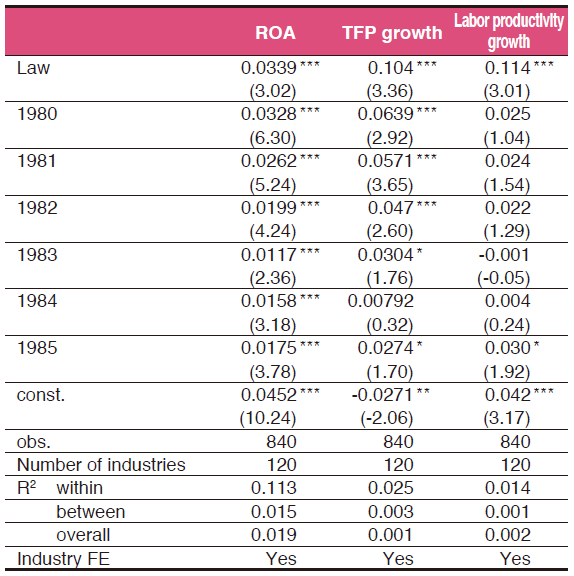
* statistically significant at 10% level.
Heteroscedasticity robust t values are in parentheses.
Structural Reforms for Activating Innovation after Long Stagnation
In 1991, the asset bubble collapsed and the Japanese economy transited to the third phase, i.e. the phase of long stagnation. In this period, the main issue of industrial policy shifted from industrial adjustment to structural reform of the economy. At first, structural reform had an aspect of international harmonization of economic institutions, in response to criticism from the US. However, as economic stagnation continued, structural reform was given a new mission, namely reform for constructing a new institutional basis for economic growth.
There is another reason behind this need for a new institutional basis of economic growth, apart from long stagnation. In the 1980s, the Japanese economy almost matched the US economy, not only in terms of per capita GDP but also in terms of total factor productivity (TFP). In other words, the Japanese economy became one of the frontrunners in the world, which implies that it faced a new challenge. From the Meiji Era, the Japanese economy had continued to grow by adopting and improving technologies from advanced countries but when the catch-up had been achieved, Japan needed to create original innovations to continue its growth.
The need for original innovations was recognized by MITI in the late 1970s. In 1979, MITI proposed the concept of Japan as a "technology-intensive nation" as a part of its "Vision for Industrial Policy in the 1980s." The vision claimed that "a turning point is coming, a move away from an industrial pattern of "reaping" technologies developed in the seedbeds of the West, to a pattern of "sowing and cultivating" that displays greater creativity. With the century of catch-up modernization at an end, from the 1980s onwards we will enter a new and unexplored phase."
One approach that MITI took to achieve economic growth based on innovation was structural reform of the economy. In 1993, the Subcommittee on Fundamental Issues of the Industrial Structure Council, under MITI, publicized the "Interim Proposal" which stressed the need for wide-ranging institutional reforms. More specifically, this proposal stressed the reform of regulations. It was stated that not only government regulations but also various private practices restricted access to the Japanese market and the emergence of new businesses. In addition to regulatory reform, it proposed a broader reform of institutions, including the corporate system, the employment system and the financial system. The idea is that, whereas these institutions worked as the foundation of the postwar growth of the Japanese economy, they were not appropriate to a new pattern of economic growth based on original innovations.
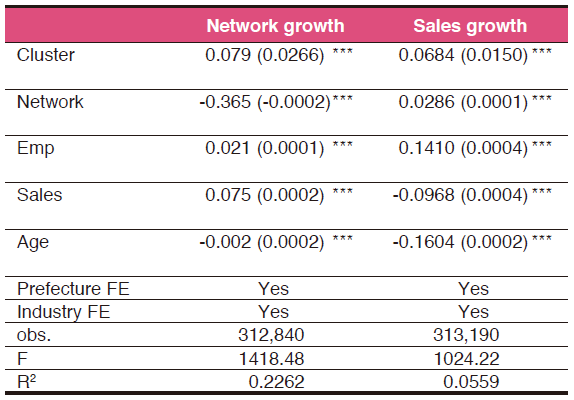
*** statistically significant at 1% level.
Indeed, structural reform of the economy has been one of the major policy issues of successive cabinets from the late 1990s until the present. The first cabinet that stressed it as an issue was the Hashimoto Cabinet (1996-1998), which gave top priority to "Six Reforms"—reforms of administration, economic structure, financial system, social security system, fiscal structure and education. These broad reforms were far beyond the jurisdiction of MITI and METI, but they played a leading role in drawing up reform plans in the cabinet, which resulted in a series of regulatory reforms, the "Japan Big Bang" of the financial system, the reform of FILIP, and the revision of the corporate law, among other reforms.
Another more specific approach to activating innovations was the industrial cluster policy that METI launched in 2001. It was a type of regional economic policy, but the aim and the contents were substantially different from the traditional regional economic policy, which intended to achieve "balanced development of regions". The industrial cluster policy was motivated by the innovation-based growth of Silicon Valley, and it aimed to promote industrial clusters incubating innovations. For this purpose, METI designated 20 industrial clusters around Japan. Many firms and universities participated in these clusters. METI supported those firms and universities to form networks with each other, and it also mediated between the firms and regional banks. Table 2 shows the results of regression analyses comparing the growth of transaction networks and sales between the firms that participated in the cluster policy program and the other firms. As shown, the firms participating in the program tended to expand their transaction networks and sales faster.
Conclusion
As stated above, the aims and tools of industrial policy in postwar Japan have changed substantially over time. It should be stressed that Japanese industrial policy is not a static set of policies but rather is characterized by flexibility. In the changing economic environment, industrial policy has been evolving to address the issues that the Japanese economy faces, devising tools under the constraints operating in each period.
This article first appeared on the March/April 2017 issue of Japan SPOTLIGHT published by Japan Economic Foundation. Reproduced with permission.
March/April 2017 Japan SPOTLIGHT


